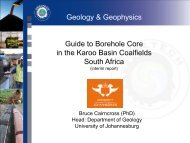coaltech upper olifants river catchment wetland inventory ...
coaltech upper olifants river catchment wetland inventory ...
coaltech upper olifants river catchment wetland inventory ...
You also want an ePaper? Increase the reach of your titles
YUMPU automatically turns print PDFs into web optimized ePapers that Google loves.
3.3.2 Birds<br />
Various bird species utilise the available habitat within the <strong>wetland</strong>s of the UORC. The<br />
various <strong>wetland</strong> types with their plant species diversity result in a variety of different habitats<br />
for the bird species to use (Barnes 2000). A large number of Red Data birds have been<br />
recorded utilising the <strong>wetland</strong>s in the <strong>catchment</strong> in the past. Due to the large distribution area<br />
of some of the bird species recorded, the populations in the <strong>catchment</strong> may make a<br />
significant contribution to the overall national number recorded for the species. The most<br />
important <strong>wetland</strong> type for bird distribution is probably the pans (Palmer et al 2002). Pans<br />
provide a great variety of habitat types including open saline water and fresh water, as well<br />
as different saturation zones (temporary, seasonal and permanent). Most water bird species<br />
are opportunistic and the diversity of species utilising artificial <strong>wetland</strong>s is also high (Palmer<br />
et al 2002, Barnes 2000, Barnes 1998).<br />
3.3.3 Mammals and Reptiles<br />
Although the <strong>wetland</strong>s are characterised by a low diversity of reptile and mammal fauna, the<br />
<strong>wetland</strong>s provide important ecological corridors for the species to receive genetic diversity<br />
from other populations (Palmer et al 2002).<br />
Three of the mammal species observed in <strong>wetland</strong>s of the UORC are Red Data species.<br />
One of these species is Critically Endangered (Rough-haired Golden Mole (Chrysospalax<br />
villosus)) and White-tailed Rat (Mystromys albicaudatus) and Oribi (Ourebia ourebei) are<br />
endangered. The Rough-haired Golden Mole occurs in grassland and has a preference for<br />
dry ground next to marshes and damp vleis (Skinner & Smithers 1990). The White-tailed Rat<br />
is closely associated with the savanna/grassland zone and is not specifically associated with<br />
<strong>wetland</strong>s (Skinner & Smithers 1990). Oribi prefer open habitat such as open grassland,<br />
floodplains and grassed vleis. They do not occur where there is a dense cover of tall grass<br />
species, but prefer short grass with a few patches of tall grass in which to hide while resting.<br />
Grazing by cattle opens the vegetation and therefore renders a site suitable for Oribi. They<br />
are not found in arid or forested areas (Skinner & Smithers 1990).<br />
Wetland Database for UORC - 25 -




